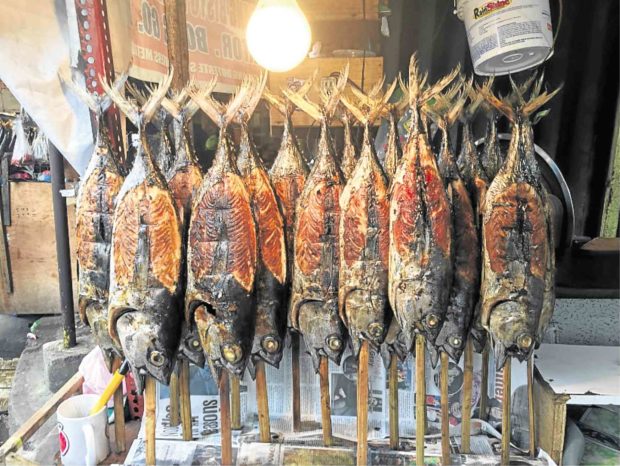
When her husband passed away in 2017, Annabel Hatol, 48, was in a quandary about what to do with her life, being a full-time housewife and mother of two children still in school.
Not long after, an opportunity opened for Hatol and her fellow Quiapo residents when the Save San Sebastian Basilica Conservation and Development Foundation Inc. (SSBCDFI) and Fundación Santiago opened a tour guiding training program in the district famous for the Shrine of Nuestra Señora del Carmen in San Sebastian Church and the image of the Black Nazarene of the Quiapo Church.
Hatol and her friend Dennis Barcelo made the final cut for the project called Bukas Quiapo Tours.
“This is my second job,” said Hatol in the recent tour of Quiapo, explaining that it is a golden moment for her, knowing well the district she now calls home.
Originally from Iloilo, Hatol’s family has been living in the Manila district for three decades now so she considers herself a “Quiapense.”
There is more to Quiapo other than the usual inner-ghetto stigma associated to it. Culturally, Quiapo has “depth,” she said.
Quiapo is a melting pot of cultures and religions from Catholicism to Islam and everything in between. Its unique and colorful Catholic devotions to the Black Nazarene and Our Lady of Mt. Carmel have made it both famous and infamous.
She added that people need not go to Mindanao to experience Muslim culture, she explained.
The sites and sights included in the tour are the Quiapo Church and Plaza Miranda; the famed Excelente Ham, Vienna Bakery, Quinta Market, Ilalim ng Tulay (Quezon Bridge), where Philippine arts and crafts are sold; the historic Bahay Nakpil-Bautista, Maglaqui Talyer with its “santo” wood carvings; and Hidalgo Street, San Sebastian Basilica and Estero de San Miguel.
Muslim Town
The tour’s highlight is the Muslim Town framed by the Estero de San Miguel and Quezon Boulevard.
Most noticeable landmark in the area is the iconic Golden Mosque, which was built in 1976 and designed by Jorge Ramos, the same architect of other Philippine landmarks such as the Zamboanga airport, the Government Service Insurance System Building in Pasay City and the Baguio Convention Center.
“Arkitekturang Filipino” by Gerard Lico says the mosque symbolizes “the nation’s Islamic heritage through modernist interpretation of Maranao design motifs in geometrized form.”
This mosque, named after the color of its dome, is the biggest in Metro Manila. It has impressive lancet arches reminiscent of mosques in Europe and Western Asia.
Around the mosque revolves the daily lives of different Islamic groups in the country that likewise call Quiapo as their home.
Traders sell various merchandise such as traditional clothing, the Muslim headwear of intricate designs, the Quran and other Islamic books, as well as mouthwatering traditional food such as “bungkaong,” which is a spicy fish dish, “palapa” side dish, beef rendang and various chicken dishes.
Grilled skewered tuna and a number of raw food materials such as the “sakurab,” a plant similar to the scallion, are also a daily street staple in Quiapo’s Muslim Town.
One place offering traditional Islamic cuisine is the June-Nairah’s Halal Restaurant on Globo de Oro Street.
Community building
SSBCDFI executive director Claire Vitug said the program was geared toward community empowerment. It is a “community building initiative more than anything else,” she added.
She explained that the Quiapo community should be involved in the project aimed at correcting the negative impressions about Quiapo.
Kara Garilao of Fundación Santiago said the project was two years in the making. It is about collaboration and building connections, she added.
She said Quiapo should be looked at as a place with a “paradigm of connections and that the district revolves around themes of hope, multiculturalism and modernity.”
Garilao added that despite Quiapo’s religious and cultural diversity, “there are many things that bring us together than apart.” —CONTRIBUTED